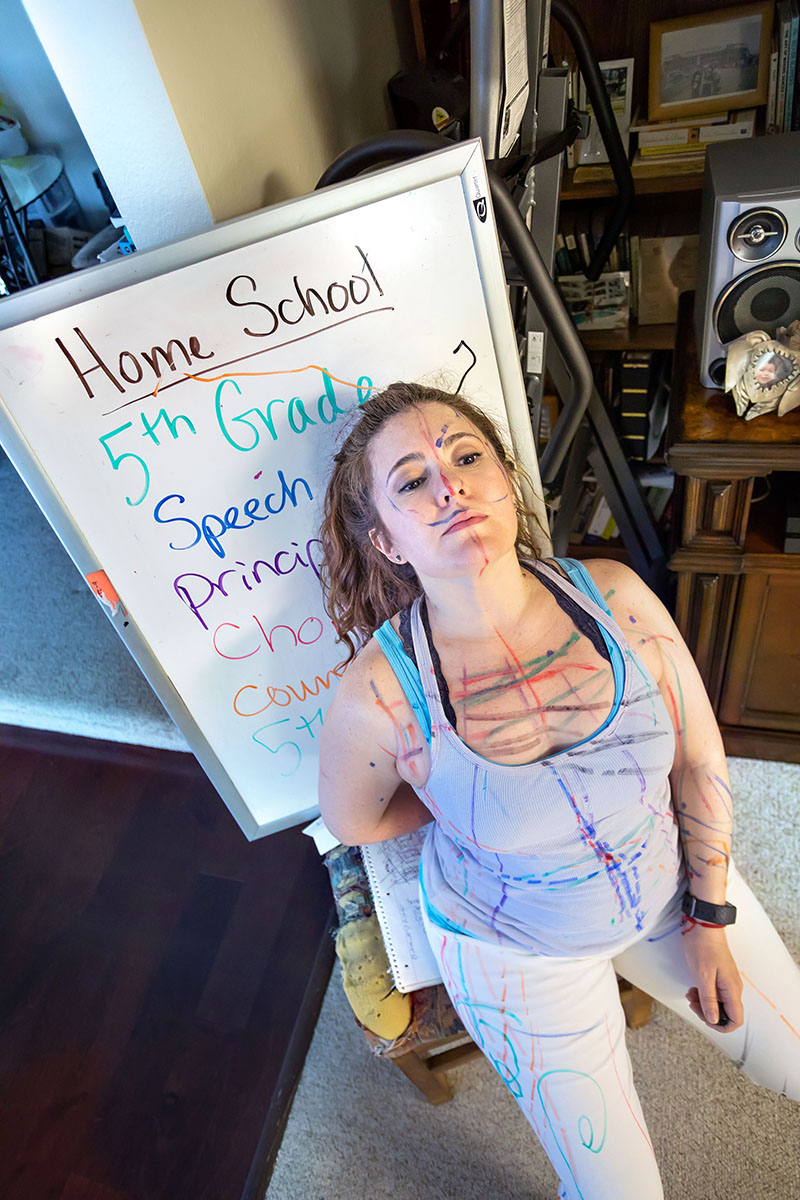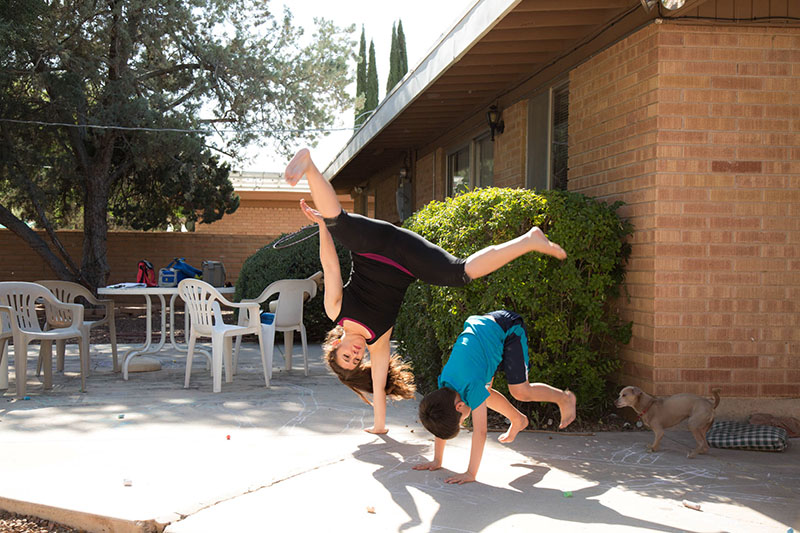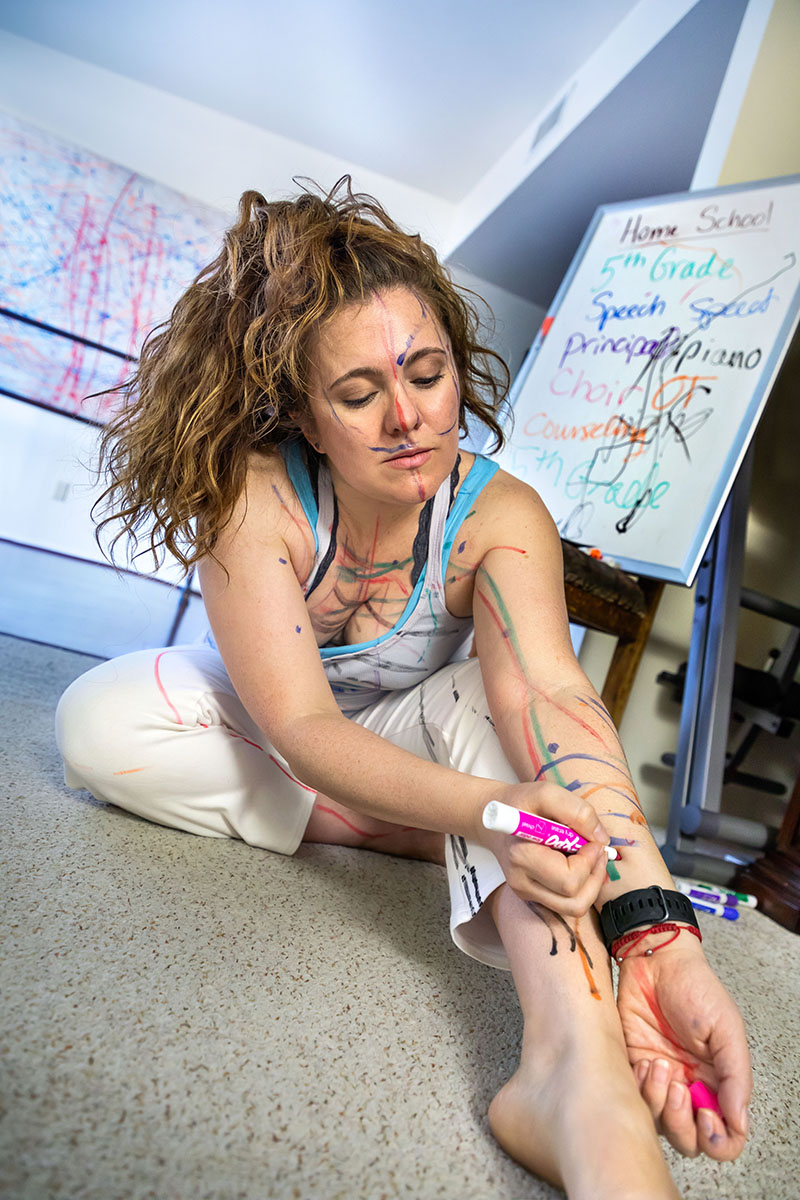Rethinking Home
An Interview with Yvonne Montoya
BY EMMALY WIEDERHOLT; PHOTOGRAPHS BY DOMINIC AZ BONUCCELLI
Yvonne Montoya is a dancer, choreographer and the director of Safos Dance Theatre in Tucson, Arizona. Her newest work, Stories from Home, was set to debut this fall but, in light of the pandemic, has been reproduced as a series of filmed episodes to share her experience as a mother homeschooling during this time, as well as to share the stories of her all-Latinx cast grappling with the present moment – from home. She describes her process creating Stories from Home: COVID 19 Addendum and her experience embodying this new reality.
Stories from Home: COVID 19 Addendum is a series of episodes, released every Wednesday from July 15th through September 23rd, on Instagram Live @mpaproject1 and on Patreon. Learn more here.

~~
Can you tell me a little about your dance history – what shaped who you are today?
I started dancing at a studio at a very young age, but it wasn’t consistent training. I come from a family of four kids, so finances were tight. I participated in ballet, tap, and jazz when I could, but it was spotty. In Albuquerque where I went to high school, I joined the dance team. After that, when I came to Tucson for college, I inquired about auditing a dance class for fun. I remember my dad saying, “It was nice you did dance in high school ‘jita, but you should focus on your academics and get a real job.” I was a first-generation college student, so it made sense why he would not want me to study dance at the university.
I ended up auditing classes anyway and getting into the higher level of jazz and modern dance at the University of Arizona. Immediately after graduation, I went to grad school and continued to audit dance classes. From there, I started dancing in some of the local modern companies in Tucson. I was always balancing dance with academia; I became adjunct faculty in my field after grad school.
At the time, there was a robust modern dance community here, but I was the only Latina in the companies, and sometimes the only person of color. I experienced a lot of microaggressions. There were immigration protests happening in the early 2000s, and comments were made because I’d be leaving rehearsal to go to a march. The demographics of Tucson were not reflected in concert dance, and I wanted to see myself in the work. I felt like I needed to choreograph because I had things I wanted to say.
I set a piece in 2006, and it got a lot of backlash. It was set to spoken word in English and Spanish. A dancer who I knew from U of A told me her family and friends don’t want to see a Mexican lady screaming in Spanish onstage. I took a break after that; it was not the first time I broke up with dance. During this dance breakup, I was chatting with friends who told me I should start my own company. In 2009, I started Safos Dance Theatre. Around that time, I also began dancing for Norman Walker, who retired here in Tucson but still gave classes and choreographed. From 2009 to 2015, I ran Safos as a traditional dance company. I worked my butt off, but Southern Arizona does not have an arts funding ecosystem to support small dance companies. For example, we don’t have foundations to fund the arts. After six years, I realized my company had hit a resource glass ceiling. In 2015, I restructured Safos to be more flexible and have a larger impact on the field of dance. Restructuring the company allowed me to spend more time with my child. My son was nine months old when I started my company. There were moments from his young life that I missed because I dedicated so much time and energy into growing the company.
In 2017, I had a bad knee injury, so I stopped dancing for Norman Walker. Around the time, I met Liz Lerman and became her mentee for my post graduate fellowship at Arizona State University. That fellowship was the catalyst that allowed me to found Dance in the Desert: A Gathering of Latinx Dancemakers in 2018. In 2019, I became a Dance/USA fellow and a Kennedy Center Citizen Artist fellow.
How has the pandemic shifted your dance practice?
Prior to the pandemic, I was working on Stories from Home, a series of dances embodying the oral traditions of Latinx communities in the American Southwest, set to debut in September at the Kennedy Center. I had a slew of rehearsal residencies lined up from April through September in different communities around the Southwest. All rehearsals and performances are now paused, postponed or cancelled. I shifted the work to an online series called Stories from Home: COVID 19 Addendum. The inspiration was twofold. My dancers were committed to these rehearsal residencies and were counting on them for income. It’s my responsibility to my community of dancers to honor the commitments they made to this project and take care of them in some way. Then there was the experience I was having homeschooling my child, which had a lot of creative energy around it. That was the inspiration to look back on a previous project of mine from 2016 called The Motherhood and The Performing Arts Project. I wanted to look at what we could do with this new creative energy.
How does the COVID 19 Addendum relate to previous work made in the Stories from Home project?
They relate, but it is a completely new body of work. It’s a separate show that is in conversation with the original project.
The original Stories from Home looks at my family’s oral histories, especially my great grandmother and father. For example, one of the first dances I made was about my father’s time as a migrant farmworker picking cantaloupe and watermelon as a child laborer in California in the 1960s. Stories from Home also touches on border stories; my partner was undocumented for many years and we have lived experiences navigating borders and immigration policies. Then there was the body of work I created with my son in 2016 that I wanted to integrate into the original Stories from Home. I had struggled since last September with my dramaturg about how to envelope my son’s stories into the work in a meaningful way to reflect connections across generations. When the pandemic happened, I decided to create contemporary stories from home that center my son and my role as a mother, now that we’re home all the time. These stories are parallel to the original body of work. For example, in the original Stories from Home, there was a dance about the 1940s Americanization program that went into the schools in northern New Mexico and punished children for speaking Spanish. That was my grandmother’s generation. Now I have a story about my son and his experience continuing school in the pandemic. The stories are in conversation with each other across time and space.
I talk about the idea of home a lot with the cast. For me, New Mexico is home, where my family comes from. I’ve been in Tucson for 20 years, so now this is home too. My partner is an immigrant whose home is three hours from here. How do we define and belong in those different homes?

Can you talk a little about the creation of the work? In particular, what has it been like incorporating your son into your artistic process?
Stories from Home: COVID 19 Addendum is in two acts. The first five episodes focus on my experiences with my son homeschooling and working from home, and the second five episodes focus on the Stories from Home cast and their stories during this time.
For the first five episodes with my son, we’re creating new pieces, as well as dusting off and re-presenting our 2016 dance film Reflections, to show the growth from when we started working together. After we finished The Motherhood and The Performing Arts Project, my son kept asking me when we were going to do another performance. Now he’s a pre-teen; he’s getting ready to go into middle school and he is less interested in working with me; I’m not cool anymore. But when the pandemic happened, I asked him if he wanted to work on a piece with me, and he said, “Sure, why not?”
He’s in piano so, for one of the first episodes, he performs live music while I dance. In other pieces, he moves, though he’s not a trained dancer. For example, we’re doing a piece about our evening walks through our neighborhood. It’s 8 o’clock and the sun is down, but it’s 100 degrees. He does some creative movement in that piece with me. He also has a strong behind-the-scenes role. He runs sound and sets up lights for our Instagram live performances. On my Patreon page, he’s put together several video blogs and blooper reels, like when I fall or step on the cat.
For the second five episodes with the Stories from Home cast, we are engaging in a week of remote rehearsals wherein dancers will choreograph their own story. I gave them the option to discuss something contemporary in their lives or to look at the stories of their ancestors. Though each episode is curated by me, it’s a time for dancers to express their voice and develop their story. It’s an opportunity that I don’t think we would have had without the pandemic. The cast is all Latinx. Even though we’re all based in the southwest, it’s been interesting developing work remotely. There’s been a lot of typing notes, sharing video, trying to find words for gestures and movements, and navigating time zones.
What do you hope viewers take away from Stories from Home: COVID 19 Addendum?
I am hopeful that viewers can relate to the material on a deep level. Many parents are struggling right now. Online school was hard for my child, and he’s starting again on August 10th.
I also hope that viewers take away that dance can be anywhere and anything. I’m literally dancing in my dining room and outside on the street. And I’m not throwing down some marley and doing pirouettes. Our bodies carry stories, and we’re all experiencing this moment. Exploring what these moments feel like in our bodies is important.
Your work sits at the intersection of several identities that are often not represented and funded in mainstream dance spaces – parenthood, Latinx communities, living in the Southwest – do you see the pandemic and recent protests as elevating and bringing more awareness to dance artists who share one (or all) of these identities, or do you think the effects of the pandemic will make it even harder on dance artists who are parents/Latinx/not living on the coasts?
Initially, I was very hopeful; as the ground is shifting, there may open space for artists on the margins. I sit at a lot of intersections that make my work invisible. I’m hoping these shifts hold possibilities for artists like me who do this kind of work to be seen and have more opportunities. I also recognize we are headed into an economic downturn and so in that respect I’m not very hopeful. Resources get tight. I’m concerned that the touring industrial complex will just look to the artists who are already on their roster, or that presenters will look to artists they have preexisting relationships with, and task them to refit work made for stages to be done online, instead of commissioning artists who make site specific work or dance for film who aren’t on their radars and take a chance to showcase what they’re doing.
Any other thoughts?
Each Stories from Home: COVID 19 Addendum episode is released every Wednesday at 1pm from July 15th through September 23rd on Patreon with supplemental materials for those who select higher tiers of support, including testimonials with dancers and the blooper reels and vlogs from my son. We will also perform excerpts on Instagram Live every Wednesday with a Q&A. That will be left on IG TV for 24 hours, so it’s very ephemeral.
~~
To learn more, visit www.yvonnemontoya.co.
Also check out her Patreon or Instagram @mpaproject1.

